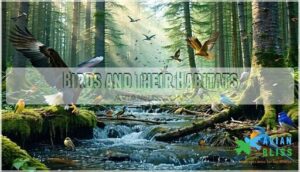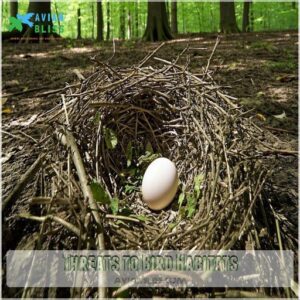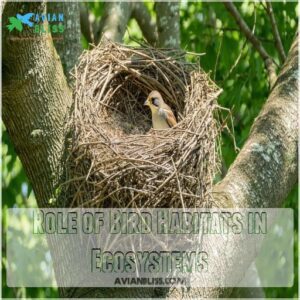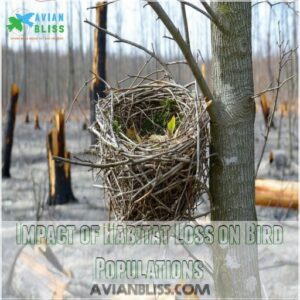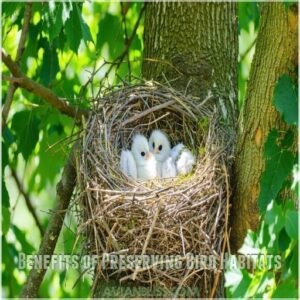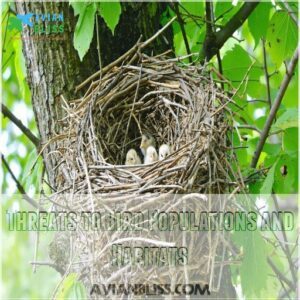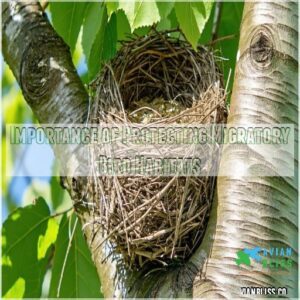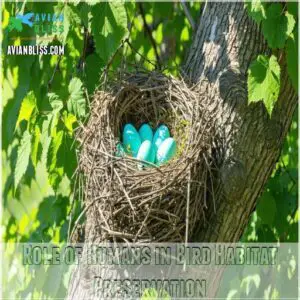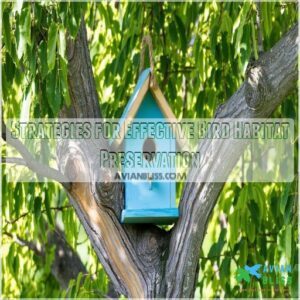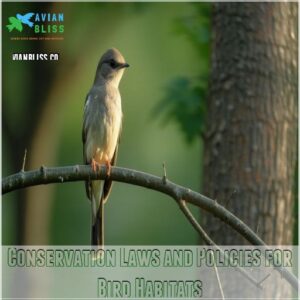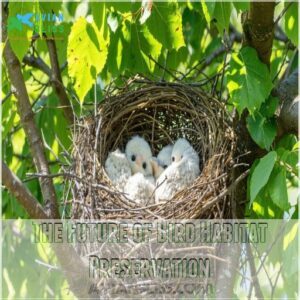This site is supported by our readers. We may earn a commission, at no cost to you, if you purchase through links.
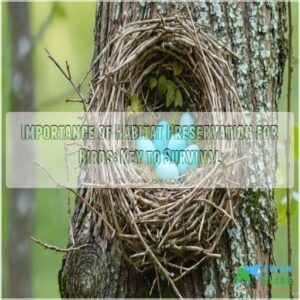
You see, birds rely on diverse habitats for food, nesting, and migration.
When these areas shrink, bird populations plummet, like a cake without its baking powder.
Why’s it essential? Healthy habitats support ecosystems, offering birds a buffet of insects and plants while balancing biodiversity.
With climate change reshaping landscapes faster than a teenager’s room during a cleaning spree, preserving these havens becomes highly important.
Curious about how your backyard might become a bird paradise? Stay tuned for ways you can play a part!
Table Of Contents
- Key Takeaways
- Birds and Their Habitats
- Why Habitat Preservation is Crucial for Birds
- Benefits of Habitat Preservation for Birds
- Threats to Bird Populations and Habitats
- Importance of Protecting Migratory Bird Habitats
- Role of Humans in Bird Habitat Preservation
- Strategies for Effective Bird Habitat Preservation
- Impact of Climate Change on Bird Habitats
- Conservation Laws and Policies for Bird Habitats
- The Future of Bird Habitat Preservation
- Frequently Asked Questions (FAQs)
- What is bird conservation?
- Why are habitat restoration and Wildlife Conservation important?
- Why do birds need habitats?
- Why is habitat conservation important?
- How can we promote bird conservation?
- Why are protected areas important for birds?
- What are the benefits of habitat preservation?
- Why is bird conservation important?
- How does habitat play an important role in the survival of the bird?
- How does habitat destruction affect birds?
- How do polluted areas affect bird habitats?
- What role do invasive species play in habitat loss?
- How does technology help in habitat monitoring?
- What are grassroots efforts for preserving bird habitats?
- How does urban sprawl impact bird migratory routes?
- Conclusion
Key Takeaways
- You’ll find that preserving bird habitats isn’t just about helping birds; it also boosts biodiversity, supports ecosystems, and helps combat climate change.
- By protecting these habitats, you’re safeguarding essential resources for birds like food and shelter, crucial for their survival and success in breeding and migration.
- Engaging in sustainable practices such as using native plants and reducing pesticide use directly contributes to maintaining healthy bird populations and habitats.
- Supporting community-led conservation efforts and participating in citizen science projects empower you to make a tangible impact on bird habitat preservation.
Birds and Their Habitats
You might wonder why birds make such a fuss about their habitats, but just like your favorite coffee shop, each habitat provides what they need for survival.
From forests to wetlands, these environments offer food, shelter, and breeding grounds, but they’re threatened by human activities and climate change, making preservation essential.
Types of Bird Habitats
Think of bird habitats as nature’s bustling neighborhoods.
Forest habitats are rich in resources, offering shelter and food.
Wetland habitats provide waterfowl with abundant snacks and nesting spots.
Grassland habitats give ample space for nesting and feeding.
Urban habitats show how birds adapt to city life, while coastal habitats challenge birds to brave tides and winds, showcasing incredible bird habitat diversity.
Importance of Bird Habitats
Bird habitats aren’t just homes; they’re the lifeblood of our feathered friends.
Picture forests as bustling cities, wetlands as thriving food markets, and urban parks as cozy cafes.
Each habitat is like a hero in a bird’s story, providing food, shelter, and nesting spots.
The rich tapestry of these environments underscores the importance of preserving bird habitat for future generations.
Threats to Bird Habitats
We’ve seen how important bird habitats are.
However, these havens face serious threats.
Habitat loss, from human development and agriculture, is a major problem.
Pollution, including pesticides, harms birds directly.
Invasive species outcompete native birds for resources.
Climate change effects are altering habitats, leading to habitat fragmentation and impacting bird populations.
Protecting these areas is key to bird habitat conservation.
Why Habitat Preservation is Crucial for Birds
You might think that a bird’s home is just a nice place to nest, but it’s actually a key part of our planet’s health.
By preserving these habitats, you’re protecting ecosystems that support biodiversity and help combat climate change.
Role of Bird Habitats in Ecosystems
Whether they’re nestled in dense forests or sweeping prairies, bird habitats brim with life and energy.
These spaces don’t just cradle biodiversity—they’re powerhouses driving the carbon cycle and weaving intricate food webs.
Like nature’s neighborhood watch, birds manage pest control, pollination, and seed dispersal.
Protecting these ecosystems guarantees the vibrancy and resilience of our natural world.
Impact of Habitat Loss on Bird Populations
Habitat loss acts like a relentless thief, stealing away essential resources that bird populations rely on.
With vanishing forests and shrinking wetlands, birds face severe challenges.
Food scarcity, nesting challenges, and reduced breeding success threaten their very survival.
As habitats disappear, the risk of species extinction grows, creating a world where bird songs might become whispers of the past.
Benefits of Preserving Bird Habitats
Preserving bird habitats is like investing in nature’s insurance policy.
It enhances carbon storage, which helps mitigate climate change, and supports biodiversity by providing safe havens for numerous species.
By using bird-friendly products from bird habitat protection, individuals can also contribute to this effort.
This not only boosts ecosystem health but also secures food security.
Protecting these areas guarantees the survival of endangered species and diverse bird populations, curbing habitat destruction for future generations.
Benefits of Habitat Preservation for Birds
You’ll find that preserving habitats for birds does more than just save their homes; it also plays a key role in storing carbon, boosting biodiversity, and shielding endangered species.
It’s like a combo meal at your favorite fast food place, but instead of fries, you get a healthier planet!
Carbon Storage and Sequestration
Imagine this: every tree and wetland plays a part in climate-smart agriculture by locking carbon away.
It’s like nature’s own savings account, storing carbon from the atmosphere.
When you focus on forest management and wetland restoration, you’re backing carbon storage, enhancing our ecological wallet.
Nature-based solutions, like carbon offsets, are your allies in this bird-friendly world.
Support for Biodiversity
Think of a bird habitat as a bustling city—each species plays a key role.
Protecting these areas means supporting species diversity and the many ecosystem services they provide.
Healthy bird habitats maintain ecosystem balance; habitat loss directly impacts birds, reducing biodiversity.
Effective conservation strategies focus on habitat connectivity, mitigating human impact.
We can all contribute to bird habitat preservation by supporting policies and actions that safeguard our feathered friends and their homes.
Protection for Endangered Species
Protecting habitats isn’t just for the sake of keeping things green and pretty; it’s a lifeline for endangered species.
Picture a world where vibrant birds, like the Ivory-billed Woodpecker, thrive instead of teetering on extinction’s edge.
By supporting conservation efforts, habitat restoration, and captive breeding, you help combat climate change impacts and guarantee bird habitat protection secures a future where diversity soars.
Threats to Bird Populations and Habitats
You face a complex challenge in protecting bird populations as their habitats face threats from habitat loss, climate change, and pollution.
Even an innocent garden weed can turn into a villainous invasive species, threatening to outcompete native plants essential for bird survival.
Habitat Loss and Degradation
Habitat loss is no small fry for our feathered friends.
When deforestation chops trees, urban sprawl crushes open spaces, and pollution clouds the skies, birds lose their homes.
Habitat fragmentation splits the landscape like a jigsaw puzzle, leaving birds homeless and stressed.
It’s crucial to support bird habitat protection before these changes clip their wings for good.
Climate Change and Its Impacts
Climate change throws bird migration patterns a curveball, leading to habitat loss and increased extinction risks.
This is exacerbated by human activities such as agriculture expansion, urban sprawl, and pollution, which further contaminate food and water sources, as seen in bird conservation efforts today.
Imagine this:
- Shifting seasons: Birds arrive to find their food sources gone.
- Rising temperatures: Habitats turn inhospitable for native species.
- Sea-level rise: Coastal bird habitats become submerged.
By understanding these climate impacts, we can develop effective conservation solutions to protect bird species and their environments.
Pesticides and Other Pollutants
Birds face another kind of invisible threat—pesticides and pollutants.
These nasties seep into their homes like uninvited guests, causing harm.
Here’s a snapshot of impacts:
| Pollutant | Effect on Birds | Source |
|---|---|---|
| Pesticides | Bioaccumulation | Agriculture |
| Heavy Metals | Neurotoxicity | Industrial Runoff |
| Oil | Feather Contamination | Spills |
| Plastic | Ingestion | Waste Pollution |
| Chemical Runoff | Habitat Loss | Urban Areas |
It’s a toxic cocktail that needs spill-proof control.
Invasive Species
Invasive species love sneaking into new places, causing havoc like uninvited guests at a party.
They outcompete native species, and this ecological impact is a major threat to bird habitats, often leading to habitat loss.
To protect bird species, implementing control methods and prevention strategies is essential.
These intruders can also cause economic consequences, stressing both nature and our wallets.
Importance of Protecting Migratory Bird Habitats
You’ll discover that protecting migratory bird habitats is essential, as these birds rely on a network of interconnected areas for survival.
Failure to conserve these habitats can disrupt their delicate migration patterns and endanger entire populations, highlighting the need for global cooperation in conservation efforts.
Flyways and Migration Patterns
While traveling the highways of the sky, birds depend on flyways to make their journeys successful.
These migration patterns act like invisible roads, ensuring safe passage for countless species.
Critical to wildlife migration and bird migration, flyways offer connectivity across diverse habitats.
They bridge fragmented landscapes, lessen climate impacts on migration timing, and support flyway health, ensuring a seamless journey.
Conservation Efforts for Migratory Birds
Conserving migratory birds is like maintaining a well-worn travel route for nature’s frequent fliers.
With millions of birds relying on intact flyways, habitat restoration becomes essential.
By tackling habitat loss and adapting to climate change impacts, you’re ensuring safe passage along wildlife corridors.
Engage in species monitoring and public involvement to safeguard these essential bird habitats and support flyway conservation.
Creating Certified Wildlife Habitats
Turning your backyard into a certified wildlife habitat is simpler than you think. Here’s how:
- Plant Native Species: They provide natural food and shelter.
- Add Water Features: Birdbaths attract thirsty birds.
- Include Bird Feeders: These draw diverse species, enriching your space.
- Create Shelter: Dense shrubs or brush piles protect from predators.
Simple steps foster thriving urban wildlife ecosystems!
Role of Humans in Bird Habitat Preservation
You play a critical role in bird habitat preservation by adopting sustainable land use practices, reducing your carbon footprint, and supporting conservation efforts.
Whether it’s planting native trees in your backyard or advocating for green policies, every action counts in creating a safer environment for our feathered friends, even if they sometimes sing before your alarm goes off.
Promoting Sustainable Land Use Practices
Adopting sustainable land use practices isn’t just for saving fields of daisies—it’s key for bird conservation too! Let your garden bloom into urban green spaces, consider wildlife corridors for your developments, and champion reforestation efforts. By creating bird-friendly urban spaces, you can provide a haven for city birds to thrive, addressing habitat loss and boosting the preservation of our feathered friends. Explore conservation easements to keep habitats intact. Your effort can transform barren lands into vibrant bird habitats, addressing habitat loss and boosting the preservation of our feathered friends.
| Sustainable Practice | Impact | Example |
|---|---|---|
| Sustainable Farming | Reduces soil erosion | Crop rotation |
| Urban Green Spaces | Increases habitat | Community gardens |
| Reforestation Efforts | Expands forests | Tree planting drives |
| Wildlife Corridors | Connects habitats | Animal bridges |
| Conservation Easements | Protects land | Permanent restrictions |
Reducing Carbon Footprint
Picture yourself reducing your carbon footprint, like swapping old appliances for eco-friendly ones or embracing renewable energy.
By doing this, you’re not just helping the planet, but also safeguarding bird habitats from climate change.
These small steps diminish greenhouse gas emissions, promoting carbon storage.
Every action counts in battling habitat loss for birds, giving nature a fighting chance.
Supporting Conservation Efforts
Supporting bird conservation isn’t just for experts; you can help too! Here’s how:
- Participate in citizen science projects, like birdwatching counts.
- Donate to or volunteer with organizations focused on habitat restoration, and explore online marketplaces like bird habitat restoration products to support conservation efforts.
- Advocate for better land management policies.
- Spread awareness through community engagement.
Every little bit helps protect our feathered friends and their homes!
Strategies for Effective Bird Habitat Preservation
You can make a huge difference in bird habitat preservation by focusing on protecting and restoring natural areas while reducing pesticide use.
Engaging in regular monitoring and research of bird populations, coupled with raising public awareness, helps guarantee these feathered friends keep singing.
Protecting and Restoring Habitats
When humans step up to help bird habitats, we’re joining a vibrant community of nature enthusiasts.
Through reforestation projects and urban green spaces, we counter bird habitat fragmentation.
Land management practices become our tools, and community involvement our rallying cry.
It’s like piecing a puzzle together—each tree and each yard counting toward habitat restoration and the fight against habitat loss.
Reducing The Use of Pesticides and Other Pollutants
Reducing pesticides and pollutants is essential for preserving bird habitats.
While pesticides promise bountiful crops, they also lead to habitat loss and chemical runoff.
For a more bird-friendly approach, consider the benefits of native plant gardening.
Opt for organic farming and sustainable gardening practices instead.
Embrace pesticide alternatives to minimize pollution impact.
Choose actions that help birds thrive and find a balance that nurtures both our fields and feathery friends.
Monitoring and Researching Bird Populations
Keeping an eye on bird populations means diving into the treasure trove of citizen science projects and habitat mapping.
You’ll use data analysis techniques to uncover bird population trends.
These insights inform conservation strategies, promoting effective bird habitat preservation.
So, plug into bird habitat monitoring and research – it’s like being Sherlock Holmes for nature, ensuring our feathered friends thrive.
Engaging The Public and Raising Awareness
Getting involved with bird habitat preservation can be as simple as participating in citizen science projects or joining educational programs.
Social media campaigns and community outreach raise awareness of habitat loss threats birds face.
Birdwatching events connect you with like-minded folks.
So, spread the word about the importance of preserving bird habitats through active bird habitat management!
Impact of Climate Change on Bird Habitats
You mightn’t notice it during your morning coffee, but climate change is busy reshaping bird habitats across the globe.
As temperatures rise and precipitation patterns shift, birds face new challenges that increase their risk of extinction.
Changes in Temperature and Precipitation
Imagine this: a robin’s nest, usually built in springtime, now faces scorching temperatures and unexpected downpours.
Climate change is messing with the usual rhythm of nature, altering temperature and precipitation patterns.
This directly impacts birds; think disrupted breeding seasons and less food availability.
Extreme weather events become more frequent, forcing birds to adapt or face habitat loss.
For many bird species, these changes are simply too much to handle.
Shifts in Migration Patterns
A little bird told me that climate change is messing with migration patterns, shaking up their travel plans like a snow globe. Here’s how:
- Timing changes: Birds may fly too early or late, missing essential resources.
- Shifted routes: Altered migratory routes lead to unfamiliar, often perilous paths.
- Habitat loss effects: Vanishing resting spots impact survival.
Increased Risk of Extinction
Birds face increased extinction risks due to habitat loss and climate change impacts.
As their migration patterns shift, habitats become fragmented or lost, leaving bird populations vulnerable.
Many bird species, such as the critically endangered Kakapo, with only 140 individuals remaining in the wild, are battling for survival due to habitat loss and threats.
Pollution and invasive species threats exacerbate this issue, shrinking safe spaces and food sources.
Without conservation solutions, threatened species battle dwindling numbers, a stark reminder that preserving their habitats isn’t just important—it’s their lifeline.
Conservation Laws and Policies for Bird Habitats
When tackling bird habitat preservation, you might wonder how laws and policies play their part.
These rules aren’t just boring legal talk; they’re essential in orchestrating international cooperation and community-led initiatives that turn plans into action for saving our feathered friends.
Implementing Conservation Laws
Conservation laws are the backbone of habitat protection, helping to shield birds from habitat loss. They help to:
- Legal frameworks set boundaries for development.
- Enforcement strategies hold violators accountable.
- Community involvement fosters local commitment.
- Habitat connectivity supports migration.
- Education raises awareness.
These elements act like a safety net, guaranteeing the importance of preserving bird habitats for future generations.
International Cooperation for Bird Conservation
Implementing conservation laws on a national level sets the stage for international cooperation.
You might think of bird conservation as a team sport that knows no borders.
Engage in global bird monitoring and adopt shared conservation strategies, and support these efforts by purchasing products that promote bird habitat protection, such as those found in Bird-Friendly Products.
Flyway management and transboundary habitat protection guarantee bird habitats thrive worldwide.
International agreements tackle habitat loss and enhance bird habitat connectivity, echoing wildlife conservation’s unified chorus.
Community-Led Conservation Initiatives
Imagine diving into community-led conservation initiatives, a vibrant approach where passion meets purpose.
You might find yourself:
- In citizen science projects, collecting data alongside fellow bird lovers.
- Nurturing community gardens, creating green refuges for bird habitat connectivity.
- Conducting local bird surveys, immersing yourself in habitat loss studies.
- Engaging in volunteer habitat restoration, transforming landscapes with grassroots advocacy.
It’s a collective effort that uplifts wildlife conservation.
The Future of Bird Habitat Preservation
You’ll see continued dedication to habitat preservation, encompassing both established methods and exciting new innovations.
This includes bolstering current conservation efforts and developing creative solutions to safeguard bird habitats for generations to come.
Continued Conservation Efforts
Saving bird habitats is like patching a leaking roof before the rainy season hits.
Focus on community engagement, scientific research, and public education.
Additionally, incorporating native plants into local conservation efforts, such as those found in bird habitat restoration projects near me Native Plant Alternatives, can greatly enhance biodiversity and support ecosystem balance.
Align funding priorities with policy reform to curb habitat loss.
Let’s look at the facts:
| Focus Area | Action | Outcome |
|---|---|---|
| Community Engagment | Foster local conservation efforts | Increased awareness |
| Scientific Research | Enhance bird habitat research | Data-driven solutions |
| Public Education | Educate on threats to bird habitat | Preservation of species |
Supporting these initiatives is pivotal to preventing further habitat loss for birds.
Innovative Solutions for Habitat Preservation
In everyone’s quest for bird habitat preservation, innovative solutions take flight. Embrace:
- Green infrastructure like urban parks to support bird populations amid concrete jungles.
- Wildlife corridors to connect fragmented habitats, enabling safe passage for winged wanderers.
- Citizen science projects that invite you to track birds and contribute to data, marrying fun with purpose. Let’s safeguard their homes, feather by feather.
Raising Awareness for Bird Conservation
Awareness for bird conservation can spread like wildfire through community involvement and birdwatching events.
Citizen science projects, paired with education programs, empower you to act.
Think of habitat restoration as a hands-on classroom where everyone learns about bird habitats and habitat loss.
Engaging in these activities promotes understanding and spurs effective habitat preservation strategies, ensuring bird habitat suitability and longevity.
Frequently Asked Questions (FAQs)
What is bird conservation?
Bird conservation is like a safety net, protecting birds from threats such as habitat loss, pollution, and climate change.
It involves understanding their needs, conserving habitats, and engaging communities to help birds thrive in our ecosystems.
Why are habitat restoration and Wildlife Conservation important?
Habitat restoration safeguards biodiversity and ecosystem services. Conserving wildlife helps species survive, preventing extinctions and maintaining ecological balance. It’s a win-win for nature and us!
Why do birds need habitats?
Why do birds need homes?
Think of habitats as cozy neighborhoods where birds find food, shelter, and space to thrive.
Without these essential spots, they’d struggle like us in a city with no grocery stores or houses.
Why is habitat conservation important?
Conserving habitats is like safeguarding nature’s home for diverse wildlife, helping them thrive.
It helps ecosystems remain balanced, supports biodiversity, and fights climate change impacts, securing a healthier planet.
It’s key for species’ survival and ecosystem health.
How can we promote bird conservation?
Imagine living in a world without songbirds’ melodies.
Promote bird conservation by planting native flora, creating bird-friendly spaces, reducing pesticide use, supporting local wildlife organizations, and advocating for policies that protect natural habitats.
Why are protected areas important for birds?
Protected areas are essential for birds, offering safe havens from human threats, preserving necessary habitats, and ensuring biodiversity.
They serve as life-support systems, protecting birds’ food sources and nesting sites, and promoting species survival and ecological balance.
What are the benefits of habitat preservation?
Habitat preservation supports biodiversity, enhances ecosystem services, and reduces climate change impacts.
It sustains food and water sources, boosts carbon storage, and guarantees species survival, benefiting you and future generations.
Healthy ecosystems make life richer and more secure.
Why is bird conservation important?
Ever notice how losing a library means missing out on countless adventures?
Bird conservation is essential because birds support ecosystems, pollinate plants, and control pests, ensuring ecological balance and indirectly securing our food supplies.
How does habitat play an important role in the survival of the bird?
Think of a bird’s home as its supermarket, restaurant, and hotel all rolled into one. Without it, finding food, shelter, and raising young becomes nearly impossible—a recipe for disaster.
How does habitat destruction affect birds?
Did you know two-thirds of North American birds are at risk due to environmental changes?
Habitat destruction forces birds to relocate, disrupts food supplies, and increases extinction risks, threatening both their survival and ecological balance.
How do polluted areas affect bird habitats?
Polluted areas can harm bird habitats by contaminating water and soil, reducing food availability, and causing health problems for birds.
This pollution disrupts ecosystems, making it difficult for birds to thrive and reproduce effectively.
What role do invasive species play in habitat loss?
Like an uninvited guest who overstays their welcome, invasive species disrupt ecosystems by outcompeting native species for food and space.
Invasive species cause habitat loss by altering food chains and ecosystems, threatening biodiversity and native wildlife’s survival.
How does technology help in habitat monitoring?
Technology, like drones and satellite imagery, helps you monitor bird habitats by providing detailed views of large areas.
This data aids in tracking changes, spotting threats, and planning conservation efforts.
Ensuring more effective habitat protection and restoration is a key benefit of this technology.
What are grassroots efforts for preserving bird habitats?
When a community builds a bird-friendly park, it’s like creating a safe haven in a bustling city.
Grassroots efforts include habitat restoration projects and citizen science initiatives, fostering local engagement in protecting essential bird environments.
How does urban sprawl impact bird migratory routes?
Urban sprawl fragments bird habitats, disrupting their migratory routes and leading to increased energy expenditure.
Birds face challenges like overcoming barriers such as buildings and roads, which can cause navigational errors, reducing breeding success and survival rates.
Conclusion
Ultimately, protecting bird habitats isn’t just about saving birds—it’s about saving ourselves.
The importance of habitat preservation for birds is paramount; their survival is intertwined with the health of our ecosystems.
Think of it as a giant, interconnected puzzle: lose one piece (a bird habitat), and the whole thing wobbles.
By actively participating in conservation efforts, you directly contribute to biodiversity and a healthier planet.
You can make a real difference, one nest at a time.
Protecting bird habitats guarantees a vibrant future for both birds and humans.

